As everyone will be aware, Cyclone Alfred is bearing down on some pretty populated parts of Queensland and New South Wales. Solar installers have been posting useful links, so without adding to the information overload we’d like to put a few of the best tips we’ve found together.
If You Have Standard Grid Connected Solar
Energex are putting out blanket advice to turn your solar power off. It’s really not necessary and it’s really pissed off the installer industry in Brisbane because the phone just won’t stop ringing.
AS4777 mandates that when the mains power goes off, so does your inverter. It’s not essential to turn solar systems off.
Unless your system has a rooftop isolator, (which nobody should be looking for in 100km/h winds) switching the DC off at the inverter really doesn’t achieve anything. By disconnecting the safety functions for earth leakage inside the inverter, arguably it makes the system less safe
To quote Brisbane Solar Repairs; Your inverter is a very clever bit of machinery – it can detect when the power is out or the grid has become unstable and turns itself off without any intervention by you.
Turn The AC Off First; Then The DC
Of course, if it makes you more comfortable you can shut the system down as a precaution.
It can be worthwhile if there are likely to be lightning strikes, power poles blown over or trees striking power lines.
In each of these scenarios, you could have a monumental voltage fed down your street. Trees can drop feeder lines, crossing them with the 230 volt street distribution system, causing a sustained injection of 11,000 volts, while a bolt of lightning may be a million more volts.
However the general advice is to have a battery-powered radio tuned to ABC local and put some ice in your freezer to transfer into the fridge if the power goes out.
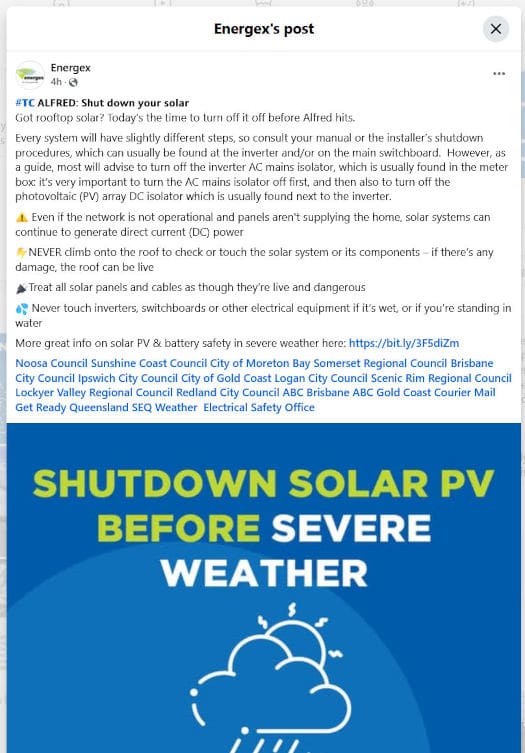
This has kicked off a storm of needless fear and unnecessary phone calls
Energex may have reasons for telling people to turn off solar, but they’re not explaining it properly.
Using temporary HV generators or piggyback network feeders, deployed as stop gaps when trying to get things back up and running means network stability can be difficult.
However, Energex’s explicit instruction to people with batteries to turn off the DC solar for “safety” reasons is just wrong.
If You Have A Battery
Lucky you: it’s worth testing the blackout function (assuming you have that option enabled at install time) by turning off the mains power.
In your main switchboard there should be a “Main Switch Normal Supply” or “Main Switch Grid Supply” or perhaps “Meter Isolator” and these should be a different-coloured label to all the rest.
Turning off the supply from the street simulates an outage so depending on your system, the lights should stay on, or they may take up to 40 seconds to come back, accompanied by a clunk from the switchboard.
Batteries May Need Some Management
Thanks here go to Scott Su at Sungrow, who has been proactive on social media in explaining how to make sure you have a full battery before the grid might go down.
Follow the red highlights to navigate the app and make sure your battery is fully charged, or try the YouTube guide here.
- First up, find the account for your installation or property
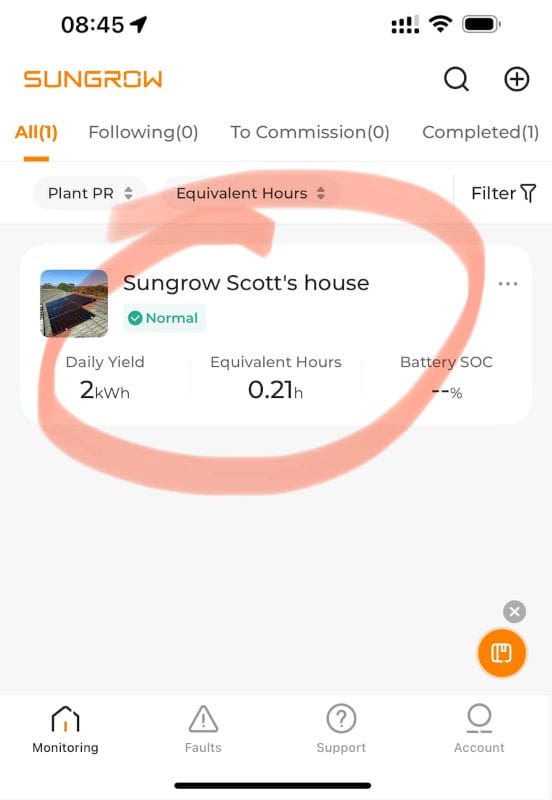
(this is an administrator screenshot so you may not encounter this view on your consumer monitoring)
- Bear in mind the apps can vary with age and installed hardware
- Scott says Select “Menu” to expand the technical settings
- On my own Sungrow app I have to select “Device” to get to the next screen
(where it says “Dashboard” in this image)
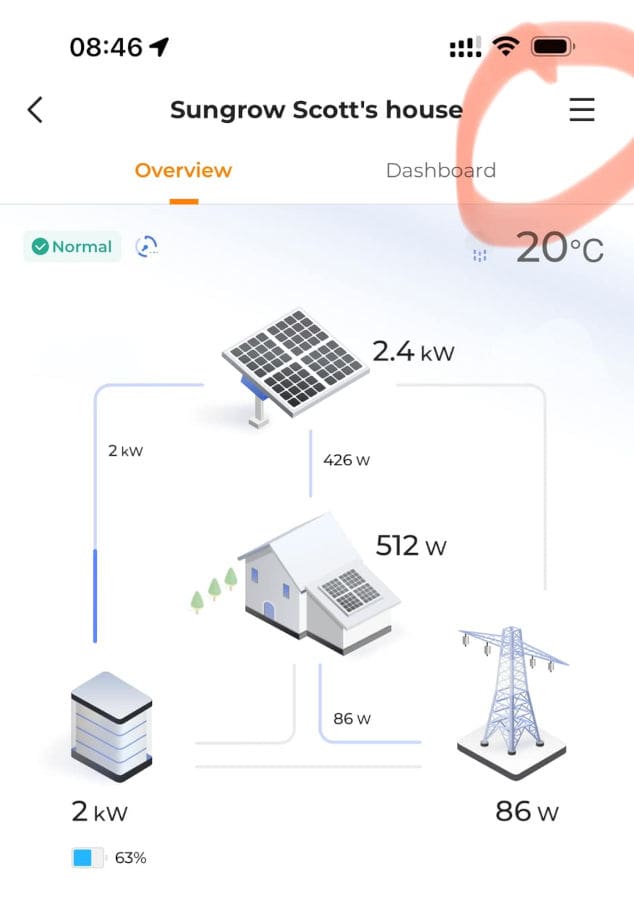
Standard three bars for MENU
- Select the “Hybrid Inverter” or “Energy Storage System”
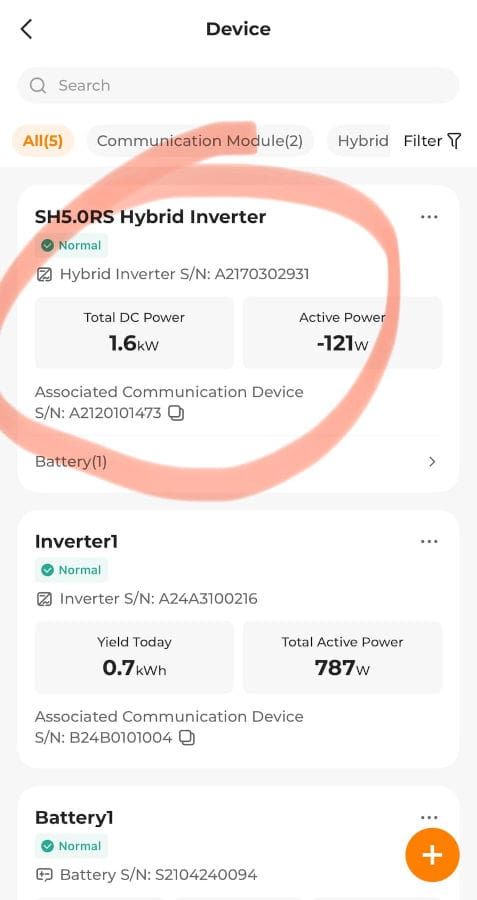
Your system may have more than 1 inverter listed.
- Slide the top bar across to find the “Settings” tab, then tap “General Settings”
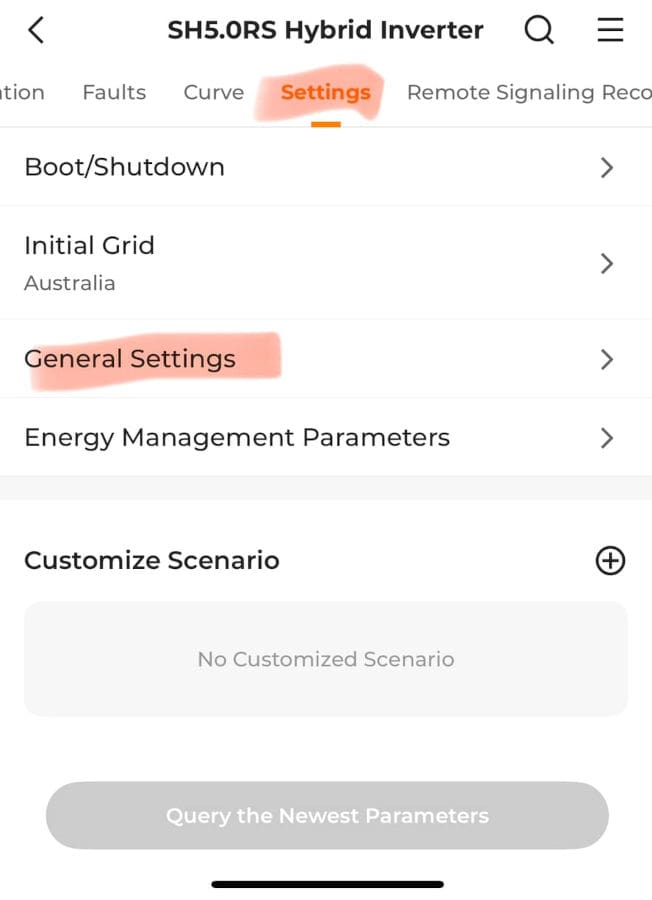
There are a lot of settings, consult your installer or possibly youtube if you’re in doubt.
- Set your battery reserve to 100% so that remains fully charged unless the grid goes missing
- ie “Please Enter 100”
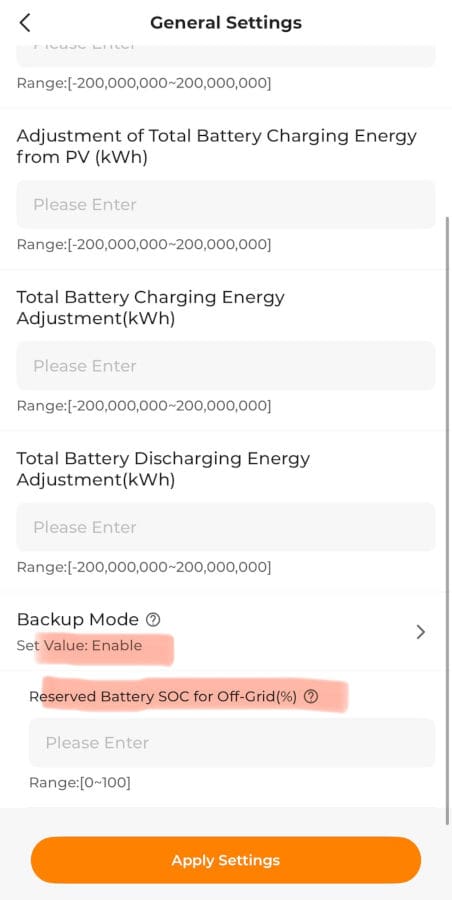
Backup mode should already be enabled provided the house has been wired for it of course.
This is a good example of the process, but Sungrow promise us they’re working on a more user-friendly toggle on the home screen to make this much easier.
Of course, if you have a different brand of solar hardware, the monitoring will look different, and there will be a different procedure.
For instance Tesla has an option called “Stormwatch” which is designed to make this battery charging happen automatically, however if you have other controls such as a retail deal with Amber or are part of a Virtual Power Plant, these might need to be disabled so you have complete control of the battery.
If You’re Wading Out Of A House That’s Going Under
Nobody is making light of this situation but the inimitable John Ingliss from Geebung’s own Positronic Solar has a very helpful video posted to Youtube.
Bear in mind this is pragmatic advice for competent people. The authorities would consider it electrical work that should legally be undertaken by trained electricians. As these qualified people are in short supply during an emergency, you may undertake these tasks at your own risk.
In this video he outlines how to deliberately short-circuit your DC solar power and render it safe by clamping the voltage to zero.
Using a clear path to circulate current is actually a safety feature employed by some inverter makers like SMA, to deal with potential earth faults.
This is quite safe to do because the wiring for DC solar arrays is drastically oversized to minimise losses. Solar panels are a current-limited source so they simply can’t overheat the wiring which is rated for double or triple the working load.
Disconnecting the AC source is no guarantee but it does mean there’s less chance the inverter will be damaged if it does suffer some moisture ingress. Disconnecting and shorting the DC will prevent the possibility of an internal inverter fire in the hours and days after the water recedes.
HOWEVER THERE IS AN IMPORTANT CAVEAT
- Since this video was recorded, most solar inverters have moved to having an onboard DC isolator inside the inverter.
- If you wish to short the array for one of these modern units, it would be best to do the work at night, as the DC solar plugs will be live when you’re trying to remove them from the inverter and connect them together.
- Separating or fumbling with live plugs will cause a significant DC arc flash, blackening and melting the pins and possibly burning your fingers and singing your eyebrows.
- If you’re in any doubt, leave well alone, it’s not worth taking the risk.
Energex Has Advice; Not All Of It Is Good
If you go to their website, there’s some general precautions in a pdf and a web page with fairly sound reasoning.
However, the blanket advice issued on social media to shut down solar power systems is causing needless fear, uncertainty and doubt.
The take-home message is:
- Treat solar power systems and components with respect, especially if they might have been flooded with water.
- If you have a power system that is likely to be inundated, get professional help to isolate, move components and short the array.
- Have your system inspected and recommissioned by a qualified installer once the weather has passed.
The fine print in your network connection agreement will specify a periodic inspection by an electrician, usually at intervals of not more than 5 years, so take the opportunity and make sure everything is good for the coming season.
Only Going To Get Worse
Though it’s been 35 years between drinks, it’s not unprecedented to have cyclones impact New South Wales, however it’s the excess rainfall and resulting floods which prove most damaging, according to the insurance industry.
As we trap more energy in the climate system with a blanket of carbon in the atmosphere, extremes of weather like this storm become more common and more powerful. There’s no debate, it’s not a matter of believing in climate change, insurers are repeatedly sticking their hands out for government subsidies.
Regardless of whether you are in the firing line of Alfred this time round, its worth getting to grips with what to do with your solar and battery system should a heavy storm come your way, since it is getting ever more likely that one will.
I just hope that maybe those lamenting even the AFL season opener had to be cancelled will begin to pay attention. If the football is being affected then this is getting serious.

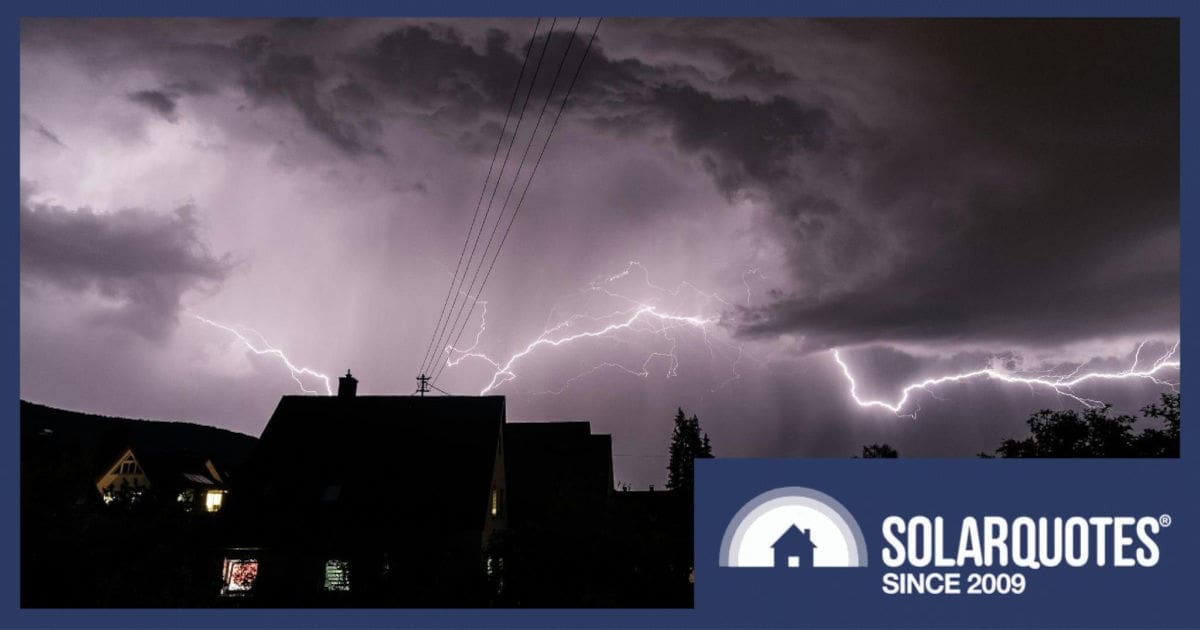
 RSS - Posts
RSS - Posts


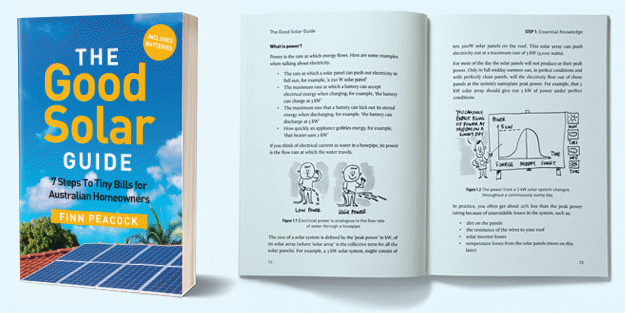
Yes Energex and their “helpful messaging” is causing no end of grief about the ridges here in south east Qld.
I live in Northern NSW, just under the BOM’s “Warning! Will Robertson!!” map (perhaps im showing my age there….) My existing solar system was put in place in 2010 and has DC rated breaker switches (just a switch not a current limiting device) and Bussman fuses in series with the array and the inverter. I don’t intend to do anything right at this stage but if I was to short the inverter DC inputs in the dead of night then I would guess that all that would happen when the sun first shines on the array (days to weeks later) is that the fuses would give up the ghost.
Of course given the panels age and expected degradation it may be that Isc (Current Short Circuit) real life isn’t sufficient to pop the fuses…..or that when they do pop it will be a longer term thermal event hours to days later rather than an immediate event due massive overload. Hopefully should that occur there wont be sufficient heat to convert the plastic switches and fuseholders to carbonised smoke as the fuses undergo torture…
In a statistically irrelevant sample size of 1, shorting the DC leads could create possibly more issues than it potentially solves.
So, Ill do nothing and simply keep away from the panels as I always try to do, and even more-so should it be determined that life as a submarine PV panel is more appropriate…….
Well put Andy,
Generally fuses were only used to protect parallel arrays from each other, say if one panel or string cable developed a fault and the other two strings were then shorted by and providing current into the faulty panel.
Fuses do eventually fail because of thermal cycling in my experience. I’ve replaced open circuit 15a (38x10mm HRC) cartridges on 5a arrays simply because they’re of an age.
Thanks for your information. Much appreciated.
Energex caused me all sorts of stress with the announcement to turn off my solar. Had only been installed the week before the cyclone so I was not confident. Anyway I did manage to turn it off.Instinctively I knew I didnt have to, and was so annoyed with how scared I felt. I wish I had seen your article in time but am now reading it post cyclone. At least I now feel informed. Thank you,
Liz
Solar panels are (almost) a constant current source – up to their rated working voltage. The short circuit current will not be much greater than the normal working current, in the order of 10% greater. So the fuses could comfortably handle a short circuit situation, they may eventually fail for other reasons, but not because the sun shines after the storm.
WOW!!! You really are showing your age. In a bad way – sorry.
The actual words used frequently were “WARNING, WARNING, WARNING”
“Danger Will ROBINSON” Not Robertson.
Again, sorry.
There are building codes for resistance to cyclones.
Is there a relevant standard for solar panel installations?
Hi Ross,
These links will help you
https://www.clenergy.com.au/media/videos/convos-with-clenergy-i-new-as-nzs1170-22021-building-standards/
https://www.gses.com.au/new-version-of-the-wind-actions-standard-as-nzs-1170-2/
Thank you for posting this. I saw the post on Facebook, but decided to ignore it as I wanted our battery to be available if there was a power outage and I was not confident to be able to turn the invertor off, but still have battery backup in case of a power outage.
Youve just saved another 30,000 phone calls from being made. Excellent.
Thanks Neil,
We do try to help.
It’s up to each owner if they want to shut there systems down and there is some good reasons to shut the system down in a major storm.
First Energex have to work on the power lines to restore power to do this they need to know that every one’s solar systems are not generating power and exporting it to the grid. Yes all inverters are designed to shut down in a grid blackout but some have had a few problems with this. I know of at least two inverters manufacturers that had a recall for this problem both of these inverters have been featured on your site, most were fixed but not all so you can see the concern that Energex has.
For the owner yes the system will shut down in a blackout but before a blackout it’s open to damage, this could be from power surges or from your roof blowing off taking the panels with it.
It just makes good sense to be safe than sorry.
Hi Martin,
Turning the DC solar off won’t help anything if the roof blows away.
Disconnecting the smarts inside the inverter that will short the array and/or sound an alert if there’s a earth fault is actually making things more dangerous.
Energex have literally been instructing people with batteries to isolate the DC solar “because it won’t generate much anyway” without considering these customers have invested in their own power systems so they’re not reliant and no longer a burden on the network. It’s utterly counterproductive yet it’s a hill they’re willing to die on.
All they’re doing is sowing FUD. Fear uncertainty and doubt aren’t helping anyone.
If the panels get ripped off the roof it will Arc the inverter damaging it and possibly worse shutting down the DC & the AC on the inverter will help prevent this. And add the risk of none compliant inverters possibly exporting power to the grid then for me better safe than sorry but then I don’t mind spending next week helping my clients turn their systems back on lol.
Hi Martin,
Great that you’re able to help people do checks & recommissioning.
Are there standard terms from Energex to mandate 5 yearly inspections & testing of islanding? I’ve seen other DNSPs require but never enforce this.
Arguably if your stay has been ripped off, or the roof with it, there are some bigger concerns than solar to be dealt with. A whole new system is probably in order.
Msrtin
Your inverter is able to. produce a fixed amount of energy. When demand for the energy exceeds its ability to supply, say for example when it single-handedly try’s to perform as a baseload generator for your entire suburb, it can either shut down extremely quickly and gracefully as designed, or self combusted about 200mS later… Either way it is not going to do as you suggest and make your local disconnected grid live. That’s a rule based on physics, not just my desire that it be so.
Of course like any rule there will be exceptions… If your local disconnected grid is tiny, and your inverter is grid forming rather than grid following and nothing in the local grid is turned on that willl exveed the inverters output litations and all the required protections don’t work in such a way as to make it unsafe…….
No person who works with lethal energised distribution network systems is ever going to rely on a “trust me it was designed safe” statement before connecting themselves to the network for maintenance. Just the same way that if an electrician comes to your house he isn’t going to take your word that the mains is off and they can just go straight ahead with re-terminating the power socket without checking that themself and then using a meter or similar to confirm at the actual socket.
There will be lots of steps in the Energex SWMS to ensure that the network is dead, and equally lots of steps to ensure it will remain that way, while they are connected to it doing maintenance……
Im amazed that the maintenance managers have time to even come up with this…it sounds to me more like a senior exec, probably from a functional or cost center other than maintenance, has “stepped in and helped” cause those maintenance boys seem to be flat out right now getting their ducks all in a line….
And right there is the problem with this industry.
Fronius have just released their app based option to keep the battery fully charged and on standby for an outage. Do you know if it charges from the grid or just stops discharge?
Hi Paul,
Not sure off the top of my head but for the sake of a dollar or two most people are fine with doing a force charge from the grid.
Sungrow have an option to activate force charging, as do Tesla and others so I imagine Fronius will do the same.
Thanks Anthony, I was just asking in case there were any adverse outcomes I wasn’t aware of and also because I am in SE Qld and didn’t want an own goal but I upgraded and gave it a go and yes it worked for me at just under 3KW with a 10KW Symo Gen24+ and a 22KWH BYD Battery. I knew I could charge from the grid but prior to this you had to go into the inverter setup to do it. This only works from the App and requires the latest update and firmware but it seems to be a pretty good idea. Regards Paul
I just used it, great timing with the cyclone coming. I can confirm it draws from the grid.
I too was happy to see Fronius add the “Battery Control” function. Couldn’t have come at a better time here in SE QLD. Welcome functionality. I tried it and it works really well. Locks the battery for 24hrs so no discharge will take place unless you have a blackout or cancel it. If your batteries require charging, it utilises solar as priority and balances draw from the grid if your solar isn’t producing enough power to charge. I only saw a rough max grid draw of around 2.5kw to charge. But, if my solar produced that amount or above it would prioritise solar use and zero draw from grid.
Your story came up in my Google suggestions. Probably because yesterday I was trying to find the answers you addressed here.
Thanks for taking the time to write this. It was helpful.
Appreciate it.
I’ll now just be relaxing and waiting for Alfred.
Anthony,
I had my first solar panels installed at least 10 + yrs ago.
I had more panels, a 2nd inverter & a battery installed 12 months ago.
My question is do I need to turn off my older inverter in this upcoming cyclone?
Hi Giz,
Without knowing how your system is set up exactly its hard to offer specific advice.
If your legacy solar system is downstream of the battery system, it could help with yield to charge your battery in an outage, well worth leaving it on.
If it’s simply grid connected then you could turn off the AC supply. If there is a spike on the network it will be less likely to damage your inverter.
The battery system may also be less likely to suffer damage if you’re running “off grid” but again, without knowing the capacity, I wouldn’t want to run the battery down prematurely.
However a close lightning strike can still blow almost anything up, connected or not.
My advice would be to leave the solar to manage itself.
Let us know how you fare.
Regarding the climate change debate and belief in climate change, yes I’m deliberately choosing triggering terms 😁 the problem is those who believe in climate change keep presenting false claims and bad science.
Bill Nye, known as the Science Guy because of his 1993-1999 kids series – he actually does hold a Bachelor of Science in Mechanical Engineering Science, and how has a Presidential Medal of Freedom courtesy of Biden, recently beclowned himself on CNN.
He stated that you can’t pretend the climate isn’t changing, that hurricanes aren’t becoming more frequent, and that flooding isn’t getting worse. He also said there’s now wildfires in the Carolinas which never used to be a thing. Short simply testable statements that allegedly prove climate change.
Except the statements fail testing. A meteorology student graphed global hurricane frequency 1980-2024. There was no increase, only variation. Likewise a geoscientist with a background in geochemistry, planetary science, and climate, graphed South Carolina wildfires – both number per year and total area burned, for 1946-2023. Numbers are so far down it’s practically zeroed out along the X axis! A couple of years before 1950 saw the largest devastation, likewise a couple of years between 1980 and 1990 saw the highest number of fires, but things are way way way down!
If climate change advocates can’t provide accurate verifiable evidence of their claims, why should Joe Public believe them? Obviously this post may not pass the mods – as this piece notes SQ hold there is no debate, it’s not about belief, but as shown, evidence presented to the public is often shiny shreddable tinfoil, not adamantium.
Hi George,
The best thing about science is that your beliefs (religious, political or otherwise) really don’t affect it.
Casting aspertions about people doesn’t change the facts they’re communicating.
Making assertions against accepted scientific consensus, without attribution or evidence, is equally as pointless.
https://www.nobelprize.org/prizes/physics/2021/popular-information/
Sadly beliefs definitely do affect science. If your beliefs aren’t acceptable then your work is deemed unkosher. Whether that means you lose your job, you don’t get into a science program, your articles get pulled from peer review journals etc varies. These are all factual examples.
In the case of Nye above, the facts he presented as proof of climate change were debunked. If they’re the only proof of climate change then climate change is clearly false.
Obviously other arguments are made elsewhere, so why didn’t he use those? Is it because many of the other arguments are more complicated and\or disputed too? If climate change is supposedly so indisputable, then why isn’t the debate black and white? Yes I’m aware it’s claimed there’s a scientific consensus about climate change, but that largely appears to be manufactured i.e. those who agree with climate change are a consensus, those who challenge it, or aspects of what’s claimed, are discounted.
Like Galileo found, when you challenge the interests of the privileged and powerful, you risk a major backlash.
Hi George,
I’m glad you’re making more arsertions without evidence, it helps establish credibility for the casual observer.
The Galileo reference is a great one too.
That’s been used by a band of plucky fossil fuel billionaires as they fight against “big science” and thousands of morally bereft academics, educators, professors and their notoriously well paid students.
Read this link about “the Galileo movement” Pty. Ltd. and it explains how unqualified luminaries like Andrew Bolt, Jo Nova & Alan Jones agree with you.
Also it shows how they sponsor Christopher Monkton… the bloke who claims he has cures for multiple sclerosis, influenza, and herpes simplex 6. (They’re conditions for which medical science has no known cures) He’s also been told to cease & desist in his claims to be an English Lord.
That’s the quality of science denial you’re harping on about. Really.
https://www.desmog.com/galileo-movement/
https://skepticalscience.com/Monckton_Myths.htm
https://aijac.org.au/update/climate-sceptic-s-nazi-jibe-offensive/
When is it ok to turn our system and battery back on
Hi Grahame
We did not turn ours off at all because when the battery was installed we paid for an instant changeover to be off grid that isolates us from the mains supply and detects when it is back. In terms of the convenience it provided well worth the $500.
You cannot have solar, a battery or a back up generator putting power out to the mains supply as that could well hurt someone but if you are isolated it is a slightly different story.
We supplemented our battery with a 2 kWh inverter generator during the day so using a trade quality extension lead from the shed all appliances were useable one at a time, for the short cycle things like the coffee maker we left it on battery and ran the toaster on the gen set.
Happy to share who set up the changeover for us if you are within 30 odd kms of Brisbane.
Cheers
Chris
Thank you for another helpful post, Antony.
May I please ask about AS4777, which mandates that when the mains power goes off, so does your inverter? Does that mean that in an extended black out of several days, a home’s solar panels cannot recharge the house battery when the sun comes out the next morning?
Many thanks
Andrew
Hi Andrew,
A hybrid inverter or AC coupled battery can be a “grid forming” machine so they’ll operate as an island of the mains power fails.
Wether you can run for days is really a balance between consumption, battery capacity & amount of sunshine available.
Eg Tesla PW 2 can operate without mains power and will run downstream AC coupled solar to meet loads and charge the battery… however if it goes flat overnight it won’t restart without the mains power returning. (Or possibly attention from a technician)
Whereas a hybrid with DC coupled solar will always charge the battery at sun up and then the system will normally restart itself.
The Energex advice was 100% the opposite of my intentions with a backup Enphase system.
I want to run essential services throughout the blackout, and I have done so for 4 days so far.
Given the amount of cyclone damage I am not expecting power to return for a week or two..
System is 15kW of PV and 10kWh of battery.
Night 1: Battery supported the reduced household demand
Day 2, 3,4 Wild weather, PV array producing omly 3-4 kWh per day and that was not enough to hold system up all night.
Next late morning the battery charges to 20% and system forms micro-grid. Fridge is the primary device to support. System shuts down before midnight.
Cycle repeats with fine tuning.
Fine tuning is drop less essential loads like HEMS, internet and mesh routers, device chargers AND the one kitchen light we were using. Fridge + candles. No more induction cooking. BBQ gas only.
At time of writing 23:00 Mon 10th, the system is still going but without HEMS and connectivity I have no idea what the exact status is. Enphase has a 4G interface but the round trip data is way behind real time.
With increasing irradiance as Ex TC Alfred moves away our expectation is continuous supply and adding back load.
Once the sun shines we can run washing machines, charge EV etc. off-grid.
What a learning curve!
Just arrived: Latest from Energex: Expected power restoral date and time is 16th at 9pm
We’re on the Gold Coast, and still without power. Estimated return is Thursday night, so that will be six days without power, in a major metropolitan area with completely underground power. And this is the second time in 14 months we’ve gone without power for that length of time, following the tornado last Christmas. Once this is all over I think Energex has a lot to answer for in terms of network resiliency, give the climate.
Anyway, I just wanted to mention our Sungrow SH10RS inverter and 9.6KWh battery. We purchased the new inverter and battery after the previous lengthy outage, and overall it has been great. The factor I did not allow for was the complete absence of any real solar to recharge the system during and immediately after the cyclone.
We have a fairly standard 6.5 KW of solar on the roof that’s about 4 years old, facing due north and due west. On a normal sunny day we make between 30 KWh and 40 KWh of solar. On an average partly cloudy way we make maybe 20-25. On our worst day on record we made about 10.
On the day of the cyclone, we made 2.5KWh. The day after, 1.3KWh. THe next two days were about 2.5KWh. Today is the first day we’ve had any sun since the event, and we had fully recharged the battery by 10.30am.
So if we’re careful, the battery gets us through the night, and we can even do some washing etc during the day.
The only thing I would have changed about the system we have is to add a way to recharge the battery from our small generator during the day. I’m told the Sungrow does allow the use of a generator connected to the GRID input, and this can be achieved a changeover switch and a high-current connector mounted on the wall, but the inverter has no way to limit the amount of power it draws when force-charging the inverter from the grid. At peak it pulls something like 5-6KW when charging, and a generator that size is just not financial feasible for us.
Perhaps something like this would work for you ? I am thinking of getting another generator the same as we already have and getting a parallel connector made up to give us 5kWh
https://www.ablesales.com.au/diesel-generators-perth-melbourne-brisbane/inverter-generator/5-0-kva-inverter-petrol-generator-package.html
You could possibly drive and collect to save transport costs.
That dark weather certainly was a Gotcha!
Today 11th was return to almost normal with 100% battery, dishwasher, internet, some TV etc.
Standby power consumption is an issue and we saved quite a lot by dropping most devices off completely.
Wish we had V2L!
Thank you Finn.
could you please best way to charge battery during an outage.
Hi Neel,
The cheapest way to charge a battery is always solar.
Otherwise you need a generator but grid connected lightweight hybrid inverters aren’t suitable.
The most resilient systems available use a Selectronic SpPro, which cope well with generators… however the imbeciles from Energex won’t allow them to be grid connected, unlike the rest of Australia.
https://www.solarquotes.com.au/blog/selectronic-sp-pro/
A Friend of mine tried following the Energex instructions, but screwed it up. He found his battery down to 3% the next morning (and his is a battery that isn’t supposed to go that low), so he turned all the switches back where they had been.
But he tells me this morning it isn’t charging today, and we have pretty good sunlight, only light cloud cover.
Hopefully for him it isn’t something expensive that needs fixing